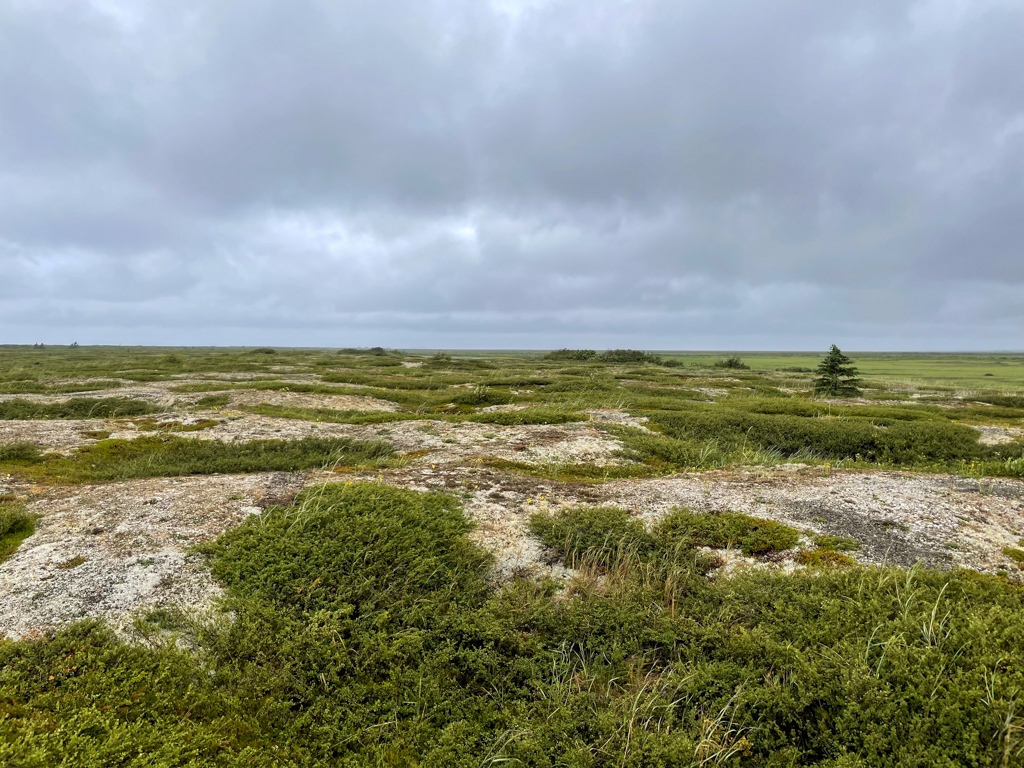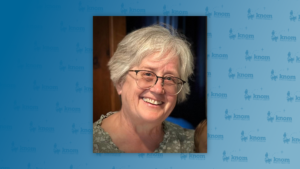Ongoing research is digging into the history of one of Alaska’s oldest archaeological sites. Take a look at an extraordinary artifact trove and the people that call it home:
Shaktoolik is a village about 100 miles away from Nome, on the coast of Norton Sound. Just outside the small community live hundreds of large indentations in the ground — indentations so large that they can easily be found on Google Earth.
These indentations are house depressions in the ancient village of Difchahak, or Tivcaraq, which the ancient culture called the Norton Tradition inhabited more than 2,000 years ago.
Difchahak is only one of numerous archaeological sites that are a part of Shaktoolik’s history — there’s also Nukleet and Iyatayet on Cape Denbigh, as well as the airport site closer to the village.
According to John Darwent, one of the researchers currently digging into ancient history, Shaktoolik is a very special destination for Arctic archaeologists. First, the sites are huge, and many are abundant with artifacts like obsidian arrowheads, net weights, and pottery.
“These sites, they’re just amazingly dense, full of artifacts. In fact, I can look in my own lab right here. And I can see there’s a huge amount of artifacts that just came out of like, you know, essentially six holes so to speak, at this one at the airport site,” said Darwent.
Second, the sites are well preserved. This is not only due to permafrost in the ground, but thanks to the intentional preservation by the people of Shaktoolik.
“There is very minimal damage to these sites. One of the things that the people of Shaktoolik seem to have done over time is protect their archaeological resources … And what’s happened at Shaktoolik is most of these sites like Difchahak and the airport site, and all the other ones that we’re working on, they haven’t been impacted by people going in and intentionally digging them up trying to damage them. So in that way, it’s a very good picture of what’s going on there. And that’s all attributed to, essentially, the people in Shaktoolik looking after their resources that are in that area,” said Darwent.
Though these large sites are so well preserved, very little research has been undertaken in Shaktoolik. In a Strait Science presentation with UAF and Alaska Sea Grant, Darwent explained that hasn’t always been the case.
“Shaktoolik actually was the center of coastal archaeology in Alaska. And that is when Jay Louis Giddings was actually working at Cape Denbigh here up just a little ways near Shaktoolik and he actually had members of the community that were working for him at that time,” said Darwent.
Based on his work, Giddings established a cultural sequence for Cape Denbigh, or a timeline that shows what cultures inhabited the ancient villages before the Yup’ik and eventually Iñupiat peoples resided there. Giddings was able to piece together that the region was first inhabited by the Denbigh flint complex, then the Norton culture, and finally the Nukleet peoples. Unfortunately, Giddings left large gaps in between each culture in the sequence.
Once Giddings moved up north to excavate in the Kotzebue region, only a handful of researchers have made trips to excavate Shaktoolik in over 70 years.
John Darwent and his team with the University of California Davis have been trying to change that. In collaboration with the Shaktoolik Native Corporation, they have been making summer trips to Shaktoolik since 2013 to excavate and fill in the blanks that Giddings left behind.
According to the sequence, the Denbigh Flint complex first inhabited the area in 2300 BC, but suddenly disappeared around 1700 BC. Darwent’s team is still determining whether the population actually left the area or if the historical record for this time period was destroyed by erosion.
To uncover what happened to the Norton culture, Darwent and his team turned to Difchahak in 2016. Although Difchahak does not have the same abundance of artifacts as the other sites, the researchers were able to find Norton artifacts like fishnet weights, projectiles, scrapers and cutters.

Later on in their research, they discovered the First Bend site, which sits on a bend next to the Tagoomenik River. Like Difchahak, First Bend turned out to be another Norton culture site. Through these sites, they discovered that the Norton culture was in the region much longer than Giddings initially thought.
“What we think is happening here, and we have to go back to confirm this, is that the Norton tradition was active in the area to about 80 AD to 880 AD. So the gap two is filling in now we only have 300 years of our gap missing now. So it really looks like people hung on in this area,” said Darwent.
After the Nukleet people, the prehistoric Yup’ik moved into the area and remained until the 1800s, when they were decimated by a smallpox epidemic. Darwent said that the airport site shows that the Iñupiat later moved in from the north.
“We know from other parts on the Seward peninsula that these were Iñupiat style houses that came into the area. And they often are, you can see here, they have a big room, a central room, and then it’s not so noticeable here, but they have actually a foyer and a tunnel that goes into it … we also have stuff that’s from the 1900s on the surface as well,” said Darwent.
Along with filling the gaps in Giddings’ Sequence, the team has also made every effort to fill in the gap between resident and researcher.
“And that’s actually one of the sins of our discipline in the past — people would do things, but they wouldn’t explain to the people who lived in the area, what was what they were doing. And so we’re trying not to do that. We’re trying to be as open about what we’re finding as possible,” said Darwent.

So, the team became a part of the community. They joined Fourth of July festivities, gave presentations and even started a Facebook group for the Shaktoolik community to ask questions and share updates.
And like Giddings before them, they also hired locals to help with the dig. Desiree Rock, who interned with the team for a few summers during high school, shared what it was like to excavate for her first job experience.
“We learned how to make excavation plots … we had to tediously shovel to be careful not to break any of the artifacts. It was pretty fun … it would be perfect squares like earth muktuk. We’d take the first top off and put it back like we were never there,” said Desiree.
While the researchers have not been able to come to Shaktoolik the last couple of summers due to the pandemic, Gary Bekoalok was more than willing to provide an unofficial tour of the sites.
And although the ancient villages may be veiled by berry bushes, squishy tundra moss and wildflowers, they are easily found a quick drive away.
Like Gary, many residents of Shaktoolik follow along with the research because they remember hearing stories about the ancient villages that have been passed down through generations. Dorothy Bekoalok, Gary’s sister, remembered hearing the stories and the purpose they had in the community.
“The old stories that they told about Iyatayet, they had teaching in the stories, the way of life, the values that we live by. You help the ones that are poor, the hungry, the widows that can’t hunt for themselves, you have to help them or you’ll have the same thing that wiped out that village,” said Dorothy.
Their brother Simon Bekoalok shared a legend about the ancient village of Difchahak. The legend not only taught the values Dorothy mentions, but tried to explain what happened to the people living in the village. The story goes that an orphaned girl was walking around Difchahak asking for food at the request of her grandmother.
“She came back to her grandma with empty hands, they didn’t give her anything. And the grandma got really upset and angry. First, Grandma got a great big wooden bucket, and she pulled from that a bucket sitting inside, from there another bucket sitting in that one, until she got half dozen or more she kept pulling out. She got to the last one, pretty small, maybe the size of a bowl. In that bucket, she pulled out two baby infant skulls, really tiny,” said Simon. “She told the girl to take these skulls and sing the song, and juggle them as she walked through the village, and they would teach them a lesson. So the girl went out, and the old woman started chanting, (the villagers) could hear her chanting. They could see this little girl with human skulls coming, singing the same song her grandma was singing inside her own house. As she passed each of the houses, she was instructed by her grandma to go and walk around the houses, one by one. And they just turned upside down.”
These stories, and the people who tell them, inform the researchers on their excavations. In turn, the researchers inform the people and their stories. As Gary explained, this cooperative relationship between the residents and research is what makes Shaktoolik and its archaeology project so special.
“I’d say Shaktoolik is kind of unique, kind of humble about our heritage, our culture, our historical past. Here in our village, we want professionals to do the digging for us … We are proud of where we come from and we want to preserve it. It belongs to the people and we just don’t bother it, we just invite the archaeologists,” said Gary.

The researchers will work in Shaktoolik during the summer as long as they are allowed to. Darwent said the sites are so large he said they could be excavating the area for at least another decade.
“And again, I can’t say too much about how friendly Shaktoolik has been to us and encouraging of our work. So it’s just a great community to work in … And as long as they will allow us to keep working there, we will,” said Darwent.
As the community of Shaktoolik moves into the future, they carry this knowledge and tradition with them.
*Update: This article previously stated that Simon Bekoalok is the uncle of Dorothy and Gary Bekoalok when in fact he is not their uncle but their brother. The correction has been made and KNOM regrets the error.
Image at top: House depressions at the ancient village of Difchahak near Shaktoolik, Alaska. Photo by KNOM.





